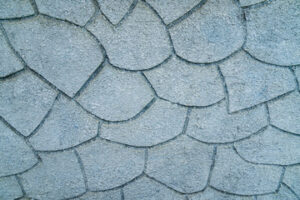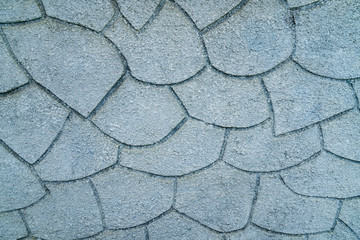Good-looking dry-stack veneer requires tight joints that are well-hidden. Significant gaps between stones look unnatural and can allow water to penetrate and weaken the wall.
Before installing the stone, dampen it to prevent it from pulling moisture from the mortar. A masonry brush or sponge can “butter” the back of the stone with mortar mix. Keep reading the article below to learn more about Concrete Stonefacing.
Stone color is a major component of the look and feel of your home. It can define the space as earthy, smoky, cool or woody. It can also enhance or compliment a particular shade of siding and interior paint colors.
Both natural and manufactured (also known as faux) stone comes in a wide range of color options. Faux stone in particular has undergone a major infusion of authenticity in recent years, often made out of concrete mixtures that are seamlessly blended and cast in molds based on the contours of real stones. These molds are then vibrated to infuse the finished product with color that runs throughout the entire piece of stone.
When choosing a stone, be sure to consider both the color of the stone as well as its texture. A more textured stone will have more visual interest, while a smoother stone may be easier to keep clean.
It’s also important to consider the look of the mortar that will be used in your project. Many manufacturers of stone veneer, including Harristone, offer a variety of different mortar dye colors that are meant to complement specific stone styles and create a cohesive design. It’s worth taking a look at their online galleries to get an idea of how certain stones will look when combined with the various mortar colors.
In addition to mortar dyes, some manufacturers offer a stone color wash that allows you to brush accent color onto the concrete during the mixing process. This technique allows the color to be absorbed into the nooks and crannies of the stone, giving it a mottled appearance that highlights the character of the material.
When installing a stone wall, you will need to decide whether or not the cladding will be “cut stone” or “masonry veneer.” Cut stone is stone that has been carved, cut and/or machined into a desired size and shape for use in projects such as treads, risers, sills, copings, borders, and hearths. It is typically installed using mortar, but can also be adhered to a structural concrete base/backing. Masonry veneer is typically a thin slab of stone that is installed on the surface of a structure like a wall or a house foundation.
Texture
Concrete is a composite construction material consisting of cement (commonly Portland cement and other cementitious materials such as fly ash and slag cement), aggregates, coarse gravel, crushed rock or granite, sand, water and chemical admixtures. When mixed with water and placed in the proper conditions, concrete hardens due to a chemical reaction with the water. It is this process that gives concrete its strength and durability. The coarse aggregates in concrete provide the structural integrity of a structure while the sand and coarse aggregate create the texture that gives the surface of a finished stone product its appearance and feel.
Manufactured stone veneer consists of a thin layer of stone applied over a substrate such as pre-existing brick, concrete or stucco. The stone is usually bonded to the substrate using mortar, although in some cases it may be glued or adhered. Natural stone veneer is made of actual rock that has been cut to a variety of shapes and sizes. The stones are then grouped together and applied to the substrate in a pattern. Natural stone veneer can be a great option for projects where the budget does not allow for the full scope of a natural stone project, or in applications where a faster installation time is desired.
Before installing the stone veneer, the substrate must be prepared. The surface must be free of dirt, waterproofing paint, form oil or any other substance that will inhibit a good mortar bond. The surface must also have a rough texture. If the substrate is a concrete or concrete masonry wall, a scratch coat must be applied and then cured prior to applying the stone veneer.
The next step in preparation is to mix the stone veneer mortar. Use a ratio of 1 part Type S masonry cement to 2.5 parts sand. Mix thoroughly to prevent clumps, adding water as needed to achieve a consistency similar to whipped potatoes. If a grout is required, use a color additive such as iron oxide pigment.
Durability
As a building material, concrete has the advantage over natural stone in that it is less expensive, yet still offers the aesthetics of full-thickness stone walls. In addition, concrete is extremely durable and able to resist damage from the elements. In fact, concrete is considered to be one of the most environmentally friendly building materials.
While there are many benefits to using Concrete Stonefacing, there are also some considerations that need to be kept in mind before purchasing and installing this product. The first is that a proper installation is vital to the longevity of this product. Incorrect installs can result in moisture soaking through the veneer and causing damage to the interior structure and framing of the house.
To prevent this from happening, RCP Block & Brick recommends using a special stone veneer mortar for affixing the stones to the wall. This type of mortar has a lower compressive strength than traditional mortar and is designed to maintain the integrity of the stone. This type of mortar is available from most local RCP locations. To ensure a proper install, it is important to follow the manufacturers instructions exactly. When laying the stone, it is essential to dampen (not saturate) the back of the stone with a small amount of the stone veneer mortar. This allows the mortar to cling to the stone and creates a stronger bond. When placing the stone, press firmly and rotate slightly to force some of the mortar to squeeze out.
If you would like to learn more about the durability of Concrete Stonefacing or how it can enhance your next building project, please contact a location near you. Our knowledgeable staff can help you plan your project and determine how much stone you will need.
Maintenance
The appearance of stone cladding is becoming more and more popular as an alternative to stucco, vinyl siding or even wood. However, just like other exterior materials, it needs regular care and maintenance to last as long as possible. Regular inspections will help to catch any small problems before they become big ones, preventing costly repairs and replacements.
Manufactured stone veneer is growing in popularity for upscale building applications, adding a rich look without the high cost of natural stone. These veneers are made from a mix of cement and crushed marble or granite, creating an appearance that is very similar to brick. While these stones are more durable than their natural counterparts, they can still be damaged from impact and weathering. This can leave the underlying concrete surface exposed, and it is important to protect this surface with proper maintenance.
Regular cleaning of stone veneer can help keep it looking beautiful for as long as possible, and it should be done with a light-duty cleaner that is safe for these types of products. Most of these cleaners are sold in a powder form that can be mixed with water to create a mild detergent solution. Then a sponge can be used to gently scrub the stone. After scrubbing, the stone can be rinsed off with clean hose water to remove any residue and make sure it is completely dry before using again.
Keeping the face of the stone free from excess mortar during installation is also crucial to its long-term performance. This is particularly true with ground faced units that have a rougher texture, as they are more susceptible to mortar smears during the installation process.
It is important to clean the stone as soon as it is installed, before the mortar hardens to a point that can’t be removed easily. It is recommended that this be done between seven and 14 days after installation.
Many cleaning chemicals that are safe for brick and mortar can be damaging to cultured or manufactured stone. This can damage the integrity of the coloring, and it can also cause the stones to lose their vibrance. When choosing a cleaning agent, it is essential to take into consideration what type of stone the product is, the timing of the cleaning, the water source, and the chemical that will be used.
